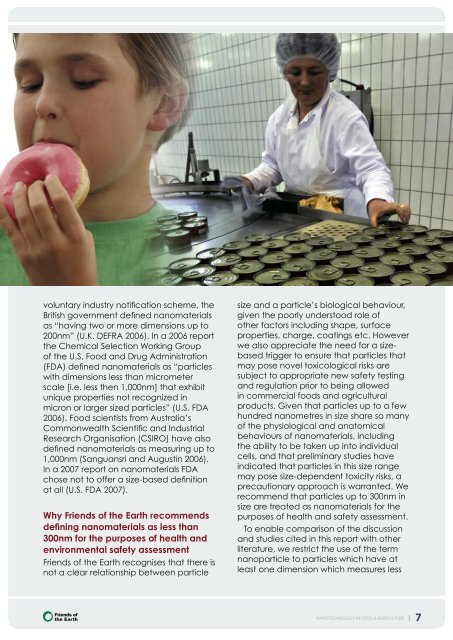Nanotechnology in Food & Agriculture - denix
Nanotechnology in Food & Agriculture - denix
Nanotechnology in Food & Agriculture - denix
You also want an ePaper? Increase the reach of your titles
YUMPU automatically turns print PDFs into web optimized ePapers that Google loves.
voluntary <strong>in</strong>dustry notification scheme, the<br />
British government def<strong>in</strong>ed nanomaterials<br />
as “hav<strong>in</strong>g two or more dimensions up to<br />
200nm” (U.K. DEFRA 2006). In a 2006 report<br />
the Chemical Selection Work<strong>in</strong>g Group<br />
of the U.S. <strong>Food</strong> and Drug Adm<strong>in</strong>istration<br />
(FDA) def<strong>in</strong>ed nanomaterials as “particles<br />
with dimensions less than micrometer<br />
scale [i.e. less then 1,000nm] that exhibit<br />
unique properties not recognized <strong>in</strong><br />
micron or larger sized particles” (U.S. FDA<br />
2006). <strong>Food</strong> scientists from Australia’s<br />
Commonwealth Scientific and Industrial<br />
Research Organisation (CSIRO) have also<br />
def<strong>in</strong>ed nanomaterials as measur<strong>in</strong>g up to<br />
1,000nm (Sanguansri and August<strong>in</strong> 2006).<br />
In a 2007 report on nanomaterials FDA<br />
chose not to offer a size-based def<strong>in</strong>ition<br />
at all (U.S. FDA 2007).<br />
Why Friends of the Earth recommends<br />
def<strong>in</strong><strong>in</strong>g nanomaterials as less than<br />
300nm for the purposes of health and<br />
environmental safety assessment<br />
Friends of the Earth recognises that there is<br />
not a clear relationship between particle<br />
Friends of<br />
the Earth<br />
size and a particle’s biological behaviour,<br />
given the poorly understood role of<br />
other factors <strong>in</strong>clud<strong>in</strong>g shape, surface<br />
properties, charge, coat<strong>in</strong>gs etc. However<br />
we also appreciate the need for a sizebased<br />
trigger to ensure that particles that<br />
may pose novel toxicological risks are<br />
subject to appropriate new safety test<strong>in</strong>g<br />
and regulation prior to be<strong>in</strong>g allowed<br />
<strong>in</strong> commercial foods and agricultural<br />
products. Given that particles up to a few<br />
hundred nanometres <strong>in</strong> size share so many<br />
of the physiological and anatomical<br />
behaviours of nanomaterials, <strong>in</strong>clud<strong>in</strong>g<br />
the ability to be taken up <strong>in</strong>to <strong>in</strong>dividual<br />
cells, and that prelim<strong>in</strong>ary studies have<br />
<strong>in</strong>dicated that particles <strong>in</strong> this size range<br />
may pose size-dependent toxicity risks, a<br />
precautionary approach is warranted. We<br />
recommend that particles up to 300nm <strong>in</strong><br />
size are treated as nanomaterials for the<br />
purposes of health and safety assessment.<br />
To enable comparison of the discussion<br />
and studies cited <strong>in</strong> this report with other<br />
literature, we restrict the use of the term<br />
nanoparticle to particles which have at<br />
least one dimension which measures less<br />
NANOTECHNOLOGY IN FOOD & AGRICULTURE | 7
















